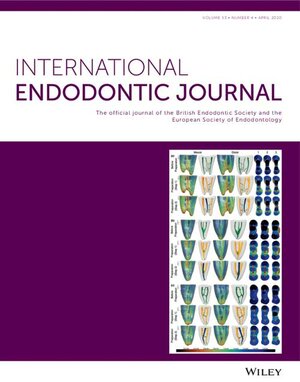Symptom correlation and spatial distribution of inflammatory mediators in pulpitis—A preliminary study
Abstract
Aim
To evaluate the association of inflammatory mediators with clinical signs and symptoms and their spatial distribution in teeth with pulpitis.
Methodology
Fifty permanent teeth from adults with clinical diagnoses of normal pulp (n = 17), reversible pulpitis (n = 13) and symptomatic/asymptomatic irreversible pulpitis (n = 20), were recruited. Two pulp blood samples from each tooth, one at the pulp exposure site (coronal blood) and one at the orifice level (radicular blood), were collected and analysed using multiplex immunoassay. The expression of 52 inflammatory mediators was analysed to compare regional variations within teeth, between groups and amongst teeth with pulpitis regrouped by symptom severity. Statistical comparisons were made using paired comparison tests at p < 0.05.
Results
TGFα and FGF-2 were significantly downregulated in teeth with reversible and irreversible pulpitis compared with healthy controls (p < 0.05). IL-1β was significantly upregulated in the radicular blood of teeth with irreversible pulpitis compared with reversible pulpitis (p < 0.05). Higher concentrations of inflammatory markers were found in the coronal blood of reversibly inflamed teeth, whilst irreversibly inflamed teeth exhibited elevated fractalkine and IL-2 in radicular regions (p < 0.05). The spatial distribution of biomarkers in teeth with pulpitis after regrouping by symptom severity demonstrated increased IL-22 in coronal blood and IL-13 in radicular blood in symptomatic teeth (p < 0.001, p < 0.05). Radicular blood of teeth with mild symptomatic pulpitis showed significantly increased levels of IL-17A but decreased concentrations of TGFα and MMP-2 compared to asymptomatic teeth (p < 0.05). Teeth with severe symptomatic pulpitis exhibited significantly higher levels of IL-1α and TGFα in coronal blood compared with asymptomatic irreversible pulpitis (p < 0.05). Symptomatic teeth generally exhibited more pronounced coronal inflammatory mediator expression.
Conclusion
IL-1β is a promising biomarker for distinguishing between reversible and irreversible pulpitis. TGFα and FGF-2 demonstrate significant potential as diagnostic biomarkers in discriminating between states of pulpitis and health. IL-1α, IL-13, IL-17A, IL-22, TGFα and MMP2 also showed potential to differentiate between teeth with symptomatic and asymptomatic irreversible pulpitis. Both classification systems used revealed distinct inflammatory mediator patterns, which were found to be correlated with symptom severity, particularly in the coronal region.


 求助内容:
求助内容: 应助结果提醒方式:
应助结果提醒方式:


